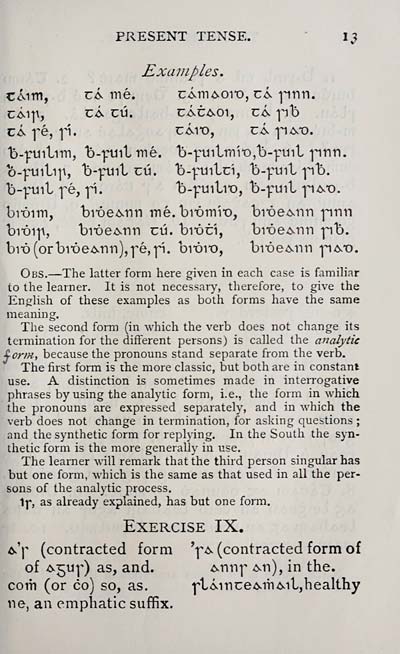Download files
Complete book:
Individual page:
Thumbnail gallery: Grid view | List view

PRESENT TENSE. I }
Examples.
cÁim, cÁ mé. cÁrn&oi-o, cÁ prm.
cÁip, cÁ cú. cÁc&oi, c^ ph
CÁ fé, p. CÁlO, c^ p&T).
fe-jruititn, b-piilrné. b-"j:tntrní'o,b-t:tiil pnn.
b-ftntin, b-put cú. b-pnlcí, b-pjiL pb.
b-ftnt fé, -pí. b-pjiti*o, b-fruit p^vo.
bi*óitn, bi-óe&rm mé. bi'ómí'o, bróe&nn pnn
bi-ói|i, biT>eMin uú. bit>cí, bi*óe&nn pb.
bit)(orbi , óe^nn),'pé,'p. bi'ói'O, biúe-Min fnvo.
Obs. — The latter form here given in each case is familiar
to the learner. It is not necessary, therefore, to give the
English of these examples as both forms have the same
meaning.
The second form (in which the verb does not change its
termination for the different persons) is called the analytic
torm, because the pronouns stand separate from the verb.
The first form is the more classic, but both are in constant
use. A distinction is sometimes made in interrogative
phrases by using the analytic form, i.e., the form in which
the pronouns are expressed separately, and in which the
verb does not change in termination, for asking questions ;
and the synthetic form for replying. In the South the syn-
thetic form is the more generally in use.
The learner will remark that the third person singular has
but one form, which is the same as that used in all the per-
sons of the analytic process.
If, as already explained, has but one form.
Exercise IX.
ty\ (contracted form Y^ (contracted form of
of ^5«f) as, and. t,r\w\ &n), in the.
com (or co) so, as. ftó,iriue&m&il,healthy
ne, an emphatic suffix.
Examples.
cÁim, cÁ mé. cÁrn&oi-o, cÁ prm.
cÁip, cÁ cú. cÁc&oi, c^ ph
CÁ fé, p. CÁlO, c^ p&T).
fe-jruititn, b-piilrné. b-"j:tntrní'o,b-t:tiil pnn.
b-ftntin, b-put cú. b-pnlcí, b-pjiL pb.
b-ftnt fé, -pí. b-pjiti*o, b-fruit p^vo.
bi*óitn, bi-óe&rm mé. bi'ómí'o, bróe&nn pnn
bi-ói|i, biT>eMin uú. bit>cí, bi*óe&nn pb.
bit)(orbi , óe^nn),'pé,'p. bi'ói'O, biúe-Min fnvo.
Obs. — The latter form here given in each case is familiar
to the learner. It is not necessary, therefore, to give the
English of these examples as both forms have the same
meaning.
The second form (in which the verb does not change its
termination for the different persons) is called the analytic
torm, because the pronouns stand separate from the verb.
The first form is the more classic, but both are in constant
use. A distinction is sometimes made in interrogative
phrases by using the analytic form, i.e., the form in which
the pronouns are expressed separately, and in which the
verb does not change in termination, for asking questions ;
and the synthetic form for replying. In the South the syn-
thetic form is the more generally in use.
The learner will remark that the third person singular has
but one form, which is the same as that used in all the per-
sons of the analytic process.
If, as already explained, has but one form.
Exercise IX.
ty\ (contracted form Y^ (contracted form of
of ^5«f) as, and. t,r\w\ &n), in the.
com (or co) so, as. ftó,iriue&m&il,healthy
ne, an emphatic suffix.
Set display mode to: Large image | Transcription
Images and transcriptions on this page, including medium image downloads, may be used under the Creative Commons Attribution 4.0 International Licence unless otherwise stated. ![]()
| Early Gaelic Book Collections > Blair Collection > Treas leabhar Gaedhilge > (19) |
|---|
| Permanent URL | https://digital.nls.uk/82321614 |
|---|
| Description | A selection of books from a collection of more than 500 titles, mostly on religious and literary topics. Also includes some material dealing with other Celtic languages and societies. Collection created towards the end of the 19th century by Lady Evelyn Stewart Murray. |
|---|
| Description | Selected items from five 'Special and Named Printed Collections'. Includes books in Gaelic and other Celtic languages, works about the Gaels, their languages, literature, culture and history. |
|---|

